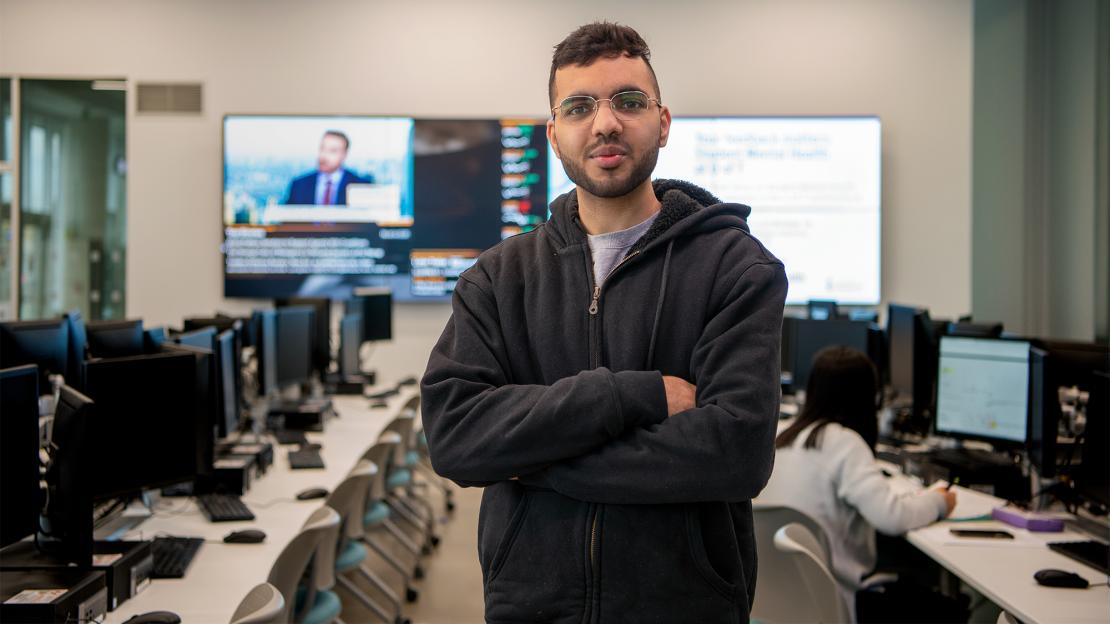This past summer, 75 U of T Scarborough students designed innovative chatbots to answer questions on Canada’s growing financial technology (FinTech) industry.
The project was unique for several reasons, but Amol Dosanjh, a third-year computer science student, particularly remembers staying up until dawn with another student to work on an entirely optional feature of their chatbot. The feature allowed admins to see charts and graphs of search statistics.
“We ended up working on an extra feature that we found really cool for many hours out of a combination of enjoyment and interest,” Dosanjh says. “This stuck in my mind as a great experience of both teamwork and friendship with a fellow software engineer.”
The project was launched in partnership with the Digital Finance Institute (DFI), a prominent Canadian think tank for FinTech, artificial intelligence (AI) and blockchain. The institute was looking for a more robust way to communicate its knowledge on the state of finance and financial technologies across Canada.
“What got me excited about the project was that I wanted to give my students an experience here in academia that would show them what to expect after they graduate,” says Abbas Attarwala, assistant professor, teaching stream, who taught the computer science class that tackled the project.
The goal was relatively straightforward — create a software that can understand mass amounts of raw data and, when asked questions about that data, give meaningful responses that imitate human conversation.
Attarwala translated the project into a course assignment. He broke it into five smaller pieces, each with a tangible component that students could deliver and demo. The teams worked in groups of four or five to design an attractive user-interface, equipped with an effective search engine and augmented with AI.
One of the DFI’s project requirements was that the chatbot make use of an existing technology. By partnering with the IBM Centre for Advanced Studies, that technology was IBM Watson Assistant, IBM’s powerful, question-answering computing platform. Watson uses AI and machine learning to understand and answer natural human language.
Dosanjh said working with the technology was the most exciting part of the project.
“Using Watson was quite exciting, especially after hearing about all of the things that people have used it for,” he says. “Most people would never have the chance to work with it, so seeing what it was capable of and leveraging its ability as part of our final product was something I really looked forward to.”
Working in groups of four or five, students created a small prototype every 10 to 15 days, received feedback from Attarwala, his TAs and the DFI, then started on the next iteration of their chatbot.
Attarwala says for computer science students, who often work individually on projects and assignments, working in a team is a valuable experience.
“When they need to think about working together as a team collectively to get a project done, these are things that I feel are really important, because in the real world they will be working in teams, they won’t be working in silos,” he says.
The project has taken content contributions from around the world, including from the United Nations. Students finished their chatbots by the end of the semester and unveiled them at the DFI’s FinTech Canada Conference in August.
The chatbot project came to campus via the Acceleration Web, which is a unique strategic management system developed in The BRIDGE, U of T Scarborough’s new multi-purpose learning space. The web harnesses industry and community partnerships with U of T Scarborough and brings them into the classroom, to create work-integrated learning opportunities for students.
“We are curating internal relationships within the university at The BRIDGE, and uncovering people with motivation, ability and opportunity to collaborate with us on doing these sorts of projects,” says Bill McConkey, academic director at The BRIDGE.
The DFI first approached the Department of Computer Science Innovation Lab (DCSIL), U of T’s computer science start-up incubator and accelerator. They were soon connected to The BRIDGE and, after, to Attarwala.
The chatbot project is the second time The BRIDGE has incorporated work with an external company into course work. It follows a similar path as the first partnership, which involved building a database system that supports newcomer settlement and service delivery in the Eastern GTA.
“We have in our mission to build these sorts of curricular partnerships, building real products doing real research for real organizations outside of the university and bringing that into the classroom,” McConkey says.
